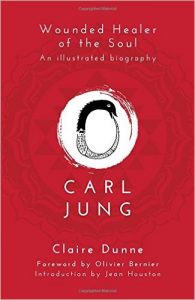 Carl Jung: Wounded Healer of the Soul by Claire Dunne
Carl Jung: Wounded Healer of the Soul by Claire Dunne
Reviewed by David Lorimer
I imagine that C.G. Jung has exerted a considerable influence on many readers of this Review – this is certainly true in my own case. I was fortunate enough to inherit from a mentor his Collected Works and read his correspondence over 20 years ago. This is a new edition of a book first published in 2000 and updated following the publication of his Red Book in 2010. It is illustrated not only with photographs but also with selected paintings illustrating the themes, some of which are taken from the Red Book and show Jung to be a notable artist. Particularly striking is the juxtaposition between a painting of the cornered shadow and a remarkable mandala, which appears only a few pages on. The book makes extensive use of quotations from Jung and his associates and conveys a vivid impression of his life and spiritual journey.
Dunne sees the three essential components of Jung’s work as applied to human life that we need to become a complete self to live whole, that God needs man to mirror his creation and help it evolve, and that the whole human being is open to God as co-creator. Jung himself embodied these principles and felt that a force of nature expressed itself through him as a channel. He stated that ‘we count for something only because of the essential we embody, and if we do not embody that, life is wasted.’ This means that we are related to something infinite beyond us, experiencing ourselves as both limited and eternal – a point reinforced by Jean Houston in her introduction.
The individuation process involves both knowing (gnosis) and alchemy or transformation. Already as a young man, Jung emphasised the importance of knowing rather than believing in a conversation with his pastor father. Much later in life, he was famously to state that he knew that God existed in an interview with John Freeman. For Jung, this meant following his own path and intuition, inevitably leading to a break from Freud and his descent into the unconscious just before the First World War. He realised that his life was both an individual and collective – indeed universal – expression, which is why his journey speaks to us today. Dunne sensitively explains the complementary roles of his wife Emma and Toni Wolff, quoting some fascinating letters from Emma to Freud. She shows extraordinary generosity of spirit in accepting both the role of Toni and the fact that guests and friends were invariably much more interested in Jung himself.
In 1923, Jung began constructing his retreat at Bollingen, where he was most himself in a Zen–like simplicity: ‘I have done without electricity, and tend the fireplace and stove myself. Evenings, I light the old lamps. There is no running water, and I pump the water from the well. I chop the wood and cook the food. These simple acts make man simple; and how difficult it is to be simple!’ He lives in a timeless zone ‘in modest harmony with nature’ – a phrase more resonant of Taoism. Visitors recall his absolute attention to the task in hand – in one case washing his blue jeans. In very cold weather he wore a long Oriental robe, looking every inch the alchemist as he concocted a sauce with 16 ingredients and enjoyed a companionable silence over good food and wine. Helena Henderson recalls that he gave the feeling that life is a good thing – ‘something even more precious to me than anything he put on paper.’ It was perhaps typical of the man that, two days before he died, he told his son Franz to find a really good bottle of wine in the cellar.
The principal women in his life died in 1953 and 1955, so he spent the last few years as a widower. During this time, he collaborated with Aniela Jaffe on Memories, Dreams, Reflections – as editor, Jaffe found that only the spiritual essence of his life’s experience remained in his memory, and he remarked that ‘the way I am and the way I write are a unity. All my ideas and all my endeavours are myself.’ There is a mystery at the heart of life as one unfolds one’s potential and holds opposites in tension, especially when encountering the numinous. This is reflected in his late book Mysterium Coniunctionis, the combining of what had been separated, whether in sexuality, mysticism or alchemy in the mystic wedding. In this respect, he felt that the role of the individual as distinct from the collective is a critical one and that we each have an important role to enact. He uses the telling analogy of the rhizome below the ground, whose true life is invisible. The expression or incarnation appears above the surface and returns to the source in due time only to reappear at another time and in another place. The genius of this beautiful book is the way that it helps readers to reflect in depth on their own journeys.
